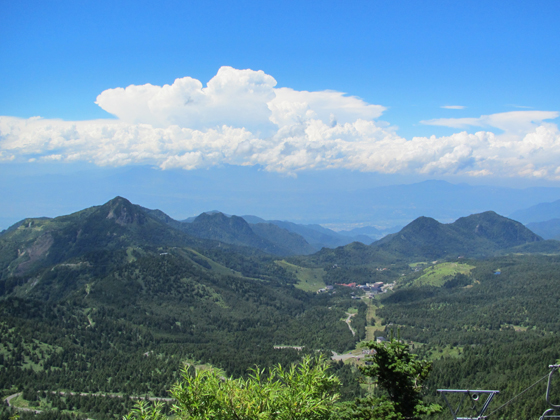Ways of Enjoying the Highland: Shiga Highland UNESCO Eco Park
Shiga Highland is well-known as a skiing mecca; it was a venue for alpine events during the Nagano Winter Olympics in 1998. And in recent years, the sight of Japanese macaques bathing in an outdoor hot spring to beat the freezing cold (“snow monkeys”) has become a popular attraction among tourists from around the world. Despite this wintry image, however, the area also has another side. In 1980 Shiga Highland was listed as a biosphere reserve (or “eco park” in Japanese) by the United Nations Educational, Scientific, and Cultural Organization (UNESCO). The core area of the Shiga Highland reserve consists of untouched virgin forest, ponds, marshland, and so on and attracts many trekkers in summer and autumn. I visited the area in search of ways to enjoy Shiga Highland.
What Is a UNESCO Eco Park?
Before writing about Shiga Highland UNESCO Eco Park, though, let me first of all explain what a UNESCO eco park is. In 1976 UNESCO launched a project, called the Man and the Biosphere Programme, aimed at conserving the ecosystem and achieving harmony between nature and sustainable development. Listed sites are officially called biosphere reserves; in Japan they are known as eco parks. At present there are seven designated eco parks in Japan, including Shiga Highland in Nagano Prefecture and Yakushima Island in Kagoshima Prefecture. Around the world there are more than 600 listed biosphere reserves, including Yellowstone National Park in the United States, Uluru (Ayer’s Rock) in Australia, and the Galapagos Islands in Ecuador. The major difference with UNESCO World Natural Heritage sites is that while these place priority on nature conservation, the biosphere reserves aim to realize a symbiosis between nature and human society. For this reason, listed sites are divided into three zones: the core area, where biodiversity is rigorously preserved; the buffer zone, where activities focus on scientific research and education; and the transition zone, where efforts are made to develop the local community as a residential area.
Trekking around the Ponds
In order to experience Shiga Highland UNESCO Eco Park, on August 21 I went on a trekking course of about 10 km around the ponds together with Ms. Katsuko Yumoto, a registered eco-park trekking guide and member of the guide association. First of all we took the summer lift from in front of Hotaru Onsen up to the summit of Mount Maeyama, which is the starting point of the course. At the starting point, we checked the direction of the eco park’s core area where we would be going. Ahead of us, Mount Shiga on the left and Mount Hachiyama on the right stood out against the blue sky. In Maeyama Marsh, the
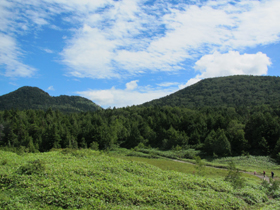
Mount Shiga & Mount Hachiyama
white iwashobu (Tofieldia japonica) flowers were swaying coolly in the breeze. At Shibuike, the first pond we came to, the insectivorous roundleaf sundew (mosengoke) plants spread out like a light-red carpet over floating islands, their red mouths wide open. The greenery of the coniferous forest and white clouds and blue sky were reflected on the surface of the water. It was just like a scene from the Hobbit village in The Lord of the Rings.
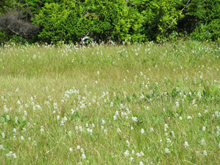
Iwashobu
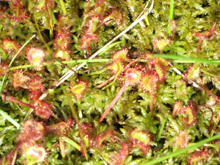
Roundleaf sundew
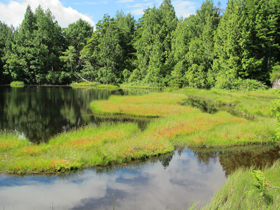
Shibuike Pond
Ms. Yumoto taught me the basic knowl-edge needed to understand Shiga Highland UNESCO Eco Park. First of all, my guide told me, the soil in this area, produced from volcanic eruptions, comprises a basic layer of red soil consisting mainly of lava, a layer of black soil consisting of humus (decomposed organic matter) mixed with weathered stone, and an upper layer of leaf litter and humus. She also explained that the virgin forest in this area was formed mainly by five trees: the Japanese thuja (kurobe), Veitch’s silver fir (shirabiso), Maries’ fir (ohshirabiso), spruce (tohi), and Northern Japanese hemlock (kometsuga). Smelling the leaf of a Northern Japanese hemlock, Ms. Yumoto added that the best time to go walking in the forest is morning, which is when we started out, because that is the time of day when trees emit the most phytoncide, an antimicrobial volatile compound.
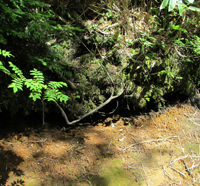
Three layers of earth
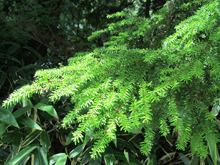
Northern Japanese hemlock leaves
Because biodiversity is preserved in the core area of Shiga Highland UNESCO Eco Park, it is possible to observe much unique flora here. I don’t have a very detailed knowledge of plants and animals, but thanks to my guide’s expertise, as we walked on I was able to spot all kinds of little inhabitants of the forest that I would not otherwise have noticed, such as the ginryoso (Monotropastrum humile), which takes in organic matter produced by the trees via mushrooms belonging to the benitake (Russulaceae) family of fungi; it is transparent white and colorless. Other flowers and fruit that delight visitors to the eco park at this time of year include the oyamarindo (Gentiana makinoi), which is a bold purple, and the gozentachibana (creeping dog-wood) with its pretty red berries.

Ginryoso
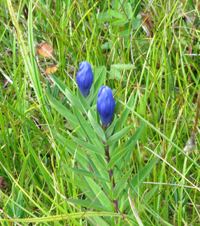
Oyamarindo

Gozentachibana

Shijuhachiike Marsh
Shijuhachiike Marsh is situated between Mount Shiga and Mount Hachiyama at a height of 1,880 meters, and there are about 60 ponds and bogs dotted around its 3.7-hectare area. We proceeded along the course, observing the vegetation by the wooden plank path and watching out for forest green tree frogs and Japanese black salamanders in the ponds.
Leaving Shijuhachiike Marsh, we went through the virgin forest and down a mountain road, from where we could see cobalt-blue water below us. This is Onuma Pond, which is the largest pond in the core area. Onuma Pond also has the highest level of acidity among the ponds in Shiga Highland UNESCO Eco Park, and there are said to be almost no fish inhabiting it at all.
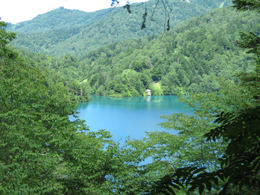
Onuma Pond
We took a lunch break at a rest house, which also serves as an emergency evacuation center. I ordered the famous nemagaridake miso soup to go with the lunch box I had brought.

Sabatake canned miso soup with bent-root bamboo
The sprouts of chishimazasa (Sasa kurilensis, a variety of dwarf bamboo), which is called nemagaridake (literally “bent-root bamboo”) in the Hokushin region, are soft and delicious, without any harsh taste. They are eaten from mid-June until early July, and apparently bears, monkeys, and humans vie to harvest them. Cans of this miso soup, called Sabatake, are sold at the roadside station as a local specialty.
Toward the end of the 10-km trekking course we spotted a chestnut tiger butterfly, which has a black outline and beautiful bluish-green pattern on its wings. The male chestnut tiger, which is said to travel 2,000 km from Japan to southern countries like Taiwan, absorbs pheromone from the honey of the yotsubahiyodori (Eupatorium glehnii) flower. The chestnut tiger’s feature is its gentle, graceful fluttering, which makes its long-distance travels all the more amazing.
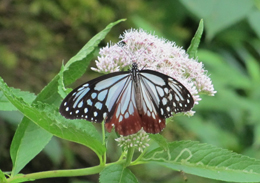
Chestnut tiger
Virgin Forest
No trees have been felled in this area since the early 1960s. When trees reach the end of their life, they gradually decay, the bark comes off, the inside softens, and they collapse naturally. New trees then sprout on top of these so-called nurse logs and grow as the next generation in a process called tree renewal. This natural changing of the guard is a feature of eco park forests that cannot be seen in artificial forests.
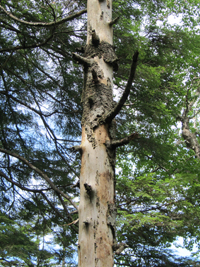
Tree without its bark
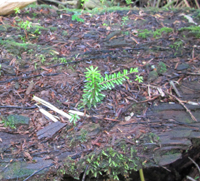
New seedlings on a nurse log
Along the trekking course around the ponds I was able to see many trees unique to a virgin forest. On the second day I took the course near the Shinshu University Institute of Nature Education. Again Ms. Yumoto acted as my guide.
The course from Misumaike Pond to Nagaike Pond, where the Shinshu University Institute of Nature Education is located, is a short one of about 1.5 km, but there are lots of spectacular sights on the way, including many examples of natural tree renewal. One of the highlights is a Northern Japanese hemlock that local children call the “elephant tree.” This tree grew with its roots exposed due to interfering rocks and became even more disfigured under the weight of snow, resulting in its peculiar “elephant-like” shape. Root exposure occurs when a tree growing on top of a nurse log or rock spreads its roots over the surface of the ground like an octopus’ legs. It is a frequent sight in the virgin forest of Shiga Highland.
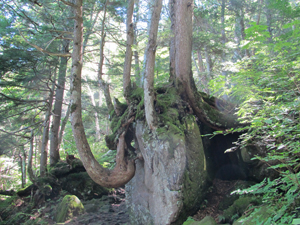
Elephant tree
For example, photo A shows a Japanese thuja and Northern Japanese hemlock, common trees in the virgin forest of this area, growing close to each other, their roots exposed above a rock. Photo B shows a kurozuru extending upward and seemingly throttling an Erman’s birch.
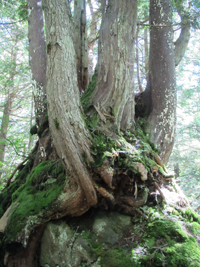
A

B
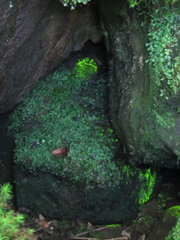
Luminous moss
In places where very little sunlight penetrates the virgin forest, such as under tree roots, in the shade of fallen trees, and in gaps between rocks, luminous moss grows. This moss does not emit light. Rather, its lens-like cells reflect the faintest of light, which then appears emerald green due to the influence of chloroplasts in the cells.
Eventually, after enjoying the unique scenery of the virgin forest and breathing in plenty of phytoncide, which is emitted by the trees in the morning, we reached the goal of today’s trekking, Nagaike Pond. When the trees parted to reveal the pond and mountain beyond, my guide Ms. Yumoto explained, “This is a marvelous spot for echoes.” She then asked students jogging past us to help out. She and the students turned in the direction of the mountain and shouted at the top of their voices “Yoo-hoo!” In an instant the echo returned—loud and clear.
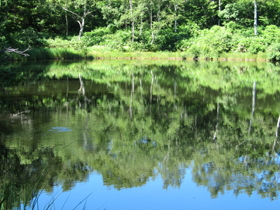
Nagaike Pond

“Yoo-hoo!”
I don’t do much walking usually, but for a day and a half I went trekking in the core area of Shiga Highland UNESCO Eco Park. To be honest, the 10-km course on the first day was quite trying. I hadn’t brought any trekking gear, but luckily the forecast of rain on that day was off the mark, and the weather had been fine. Nevertheless, I am glad that at least I had worn trekking shoes. In order not to spoil the natural environment, this area is kept untouched as much as possible. So apart from the wooden plank paths, the trails are covered in mud and stones and are very hard to walk along. It is like walking along animal trails or a dry riverbed.
Exhausted in a pleasant sort of way, I bid farewell at Nagaike Pond to Ms. Yumoto and Shiga Highland UNESCO Eco Park. The tiger lily flowering on the side of the pond seemed to wave a cheery goodbye as well.
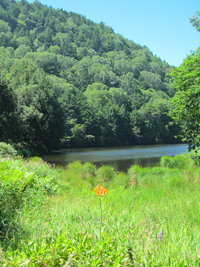
Relaxing in Nature
I had heard that this summer students of the Rikkyo University College of Tourism were conducting a local support project at Shiga Highland, so I went along to their summer-only café at Shiga Highland Gate-way Station.
Under the guidance of Professor Takayuki Shoji of the College of Tourism, about 10 students had set up the Reader’s Lounge café with the concept of “enjoying reading in a magnificent natural setting.” The café served beer, wine, apple juice, ice cream, and other popular local products and was equipped with tablet computers provided by a telecommunications company, electronic contents provided by a printing company, and outdoor goods courtesy of an outdoor specialty store.
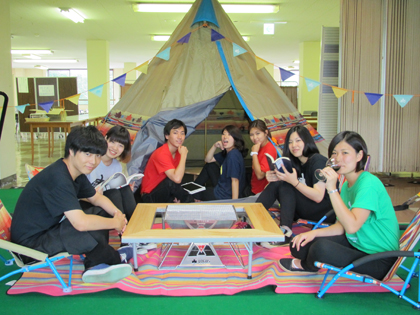
Students of the Rikkyo University College of Tourism
Sinking my weary body into a deckchair, I ordered coffee and the ice cream that my guide Ms. Yumoto had recommended. This Wakabaya gelato, which is said to be popular at Shibu Onsen, uses Okushiga Highland raw milk. The elegant sweetness of the summer-only peach ice cream did indeed sooth my tired limbs.
I asked Kota Masuda, a third-grade student in the College of Tourism, about the project. He explained that the idea was to enable people, tired after trekking, to relax and enjoy reading and local food in the café. It was certainly an ideal place for me that day, which had been fine and perfect for trekking. It would also be a good place on days when bad weather rules out open-air activities. Highland weather is so changeable after all.
The idea also was for the tablet computers provided in collaboration with a company to be used not only for reading books but also for obtaining local tourist information. Mr. Masuda admitted honestly, however, that the scheme had not really worked. “Elderly people who come here for trekking are not accustomed to tablet computers and e-books,” he said, “so it’s mainly the younger people who use them.”

Sketching the landscape
Suddenly I noticed that there was somebody by the window sketching something while looking at the scenery outside. When I asked, she said her name was Asumi Ito and she was studying Japanese painting at an art university. Ms. Ito had a temporary job working at a nearby lodging for a couple of weeks and had come to the Reader’s Lounge café for the first time that day. “The scenery outside the window is so wonderful,” she said, showing me her sketch.
There was another young fellow eagerly reading a book who apparently had been coming here almost every day to read. When I approached him, he said his name was Yusuke Hasebe and he was studying business management at university. Like Ms. Ito, he was working for two weeks in the area. Mr. Hasebe had been at Shiga Highland for about 10 days, and he described it as being “just like the world of Princess Mononoke.” He had seen genjibotaru fireflies, foxes, and monkeys, he said, and the starry skies were beautiful. At the moment, he said, he was reading Dostoevsky’s The Brothers Karamazov.
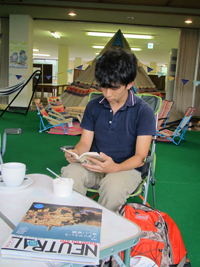
Reading classic literature
To Each Their Own
There are many ways to enjoy Shiga Highland. Energetic people can go trekking and see the nature in one of Japan’s seven UNESCO eco parks, absorbing plenty of phytoncide and fortifying themselves even more. People who like their food can enjoy the nemagaridake, which local people look forward to eating every year and compete with the bears to harvest, as well as the ice cream, fruit, local sake, local beer, and other local cuisine. And people who like a more sedentary lifestyle can relax in a hot spring and then read some classic literature by a window looking out to starry skies. Everyone is sure to come away fully satisfied.
Although it wasn’t on my schedule, the weather that day was excellent, so I took the summer lift up to the top of Mount Yokote, the highest peak in Shiga Highland. From the 2,307-meter-high summit, you get a panoramic view of the whole of Shiga Highland, and on a cloudless day you can see as far as the Northern Alps and Mount Fuji. Trekking through nature is an enriching experience, but getting a bird’s-eye view of the world from atop Mount Yokote is refreshing as well. I hope people enjoy Shiga Highland UNESCO Eco Park—each in their own way.
